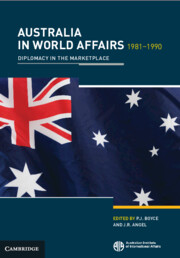Book contents
- Frontmatter
- Contents
- Preface
- Introduction
- Part 1 Australia and the World
- Part 2 Australia and the Regions
- 7 Australia and the United States
- 8 Australia and Southeast Asia
- 9 Australia and the South Pacific
- 10 Australia and the United Kingdom
- 11 Australia and Western Europe
- 12 Australia and the Eastern Bloc
- 13 Australia’s relations with Japan and the Korean Peninsula
- 14 Australia and China
- 15 The Commonwealth connection: a contemporary history and prospect
- Index
8 - Australia and Southeast Asia
from Part 2 - Australia and the Regions
Published online by Cambridge University Press: 29 March 2024
- Frontmatter
- Contents
- Preface
- Introduction
- Part 1 Australia and the World
- Part 2 Australia and the Regions
- 7 Australia and the United States
- 8 Australia and Southeast Asia
- 9 Australia and the South Pacific
- 10 Australia and the United Kingdom
- 11 Australia and Western Europe
- 12 Australia and the Eastern Bloc
- 13 Australia’s relations with Japan and the Korean Peninsula
- 14 Australia and China
- 15 The Commonwealth connection: a contemporary history and prospect
- Index
Summary
In the decade under review, there were signs of a lessening of outside great-power interference in regional affairs. The regional-security situation and the prospects for regional stability have in this respect provided grounds for optimism, although the situation is not entirely one which traditional Australian foreign policy in the region has sought. The long-perceived threat to regional stability posed by potential communist interference has been reduced not so much because of increased Western influence but more because of initiatives by Southeast Asian countries and, more dramatically, by the implications for world and regional affairs of the moves in the Soviet Union and China towards more open societies and towards economic priorities more responsive to free market influences. Also encouraging have been the indications from 1987 that the rivalry between these two countries was ending, although the Chinese repression of the pro-democracy movement has raised doubts about China’s development along the path to reform.
Keywords
- Type
- Chapter
- Information
- Australia in World Affairs 1981–1990Diplomacy in the Marketplace, pp. 146 - 166Publisher: Cambridge University PressFirst published in: 2024



